No planning hotels, tours, where and what to eat.
Just pick your cruise location and PAY Ya! money.
River Cruisin' at it's best!! http://www.pandaw.com/
Setting the SCENE
A Pandaw river expedition is not like an ocean going cruise. There is no dressing up for dinner and no 'captain's table'. The atmosphere on board is very friendly and informal, more like a party on a private yacht than a cruise ship. Nearly everything is included in the price and there are no hidden extras for excursions. Even your drinks are included in the price of your ticket. There is an incredibly high level of personal service and care aboard, with a crew passenger ratio of 1:2.
All ships were built new and designed and finished as
replicas of colonial river steamers.
replicas of colonial river steamers.
RV Mekong Pandaw
Specification
Length - 200ft / 60m Beam - 36ft / 11m Draught - 4ft / 1.5m Berths - 64 pax Decks 4: Lower, Main, Upper, Sun Engines 2 x 550bhp Isuzu Built 2003
The MEKONG RIVER & DELTA
The Mekong Delta (“Nine Dragon river delta”) is the region in southwestern Vietnam where the Mekong River approaches and empties into the sea through a network of distributaries. The Mekong delta region encompasses a large portion of southwestern Vietnam of 39,000 square kilometres (15,000 sq mi). The size of the area covered by water depends on the season.
The Mekong is a river that runs through China, Burma, Laos, Thailand, Cambodia and Vietnam. It is the world's 10th-longest river and the 7th-longest in Asia. Its estimated length is 4,909 km (3,050 mi), and it drains an area of 795,000 km2 (307,000 sq mi), discharging 475 km3 (114 cu mi) of water annually.
The extreme seasonal variations in flow and the presence of rapids and waterfalls in this river have made navigation difficult. The river is a major trading route linking China’s southwestern province of Yunnan to the South China Sea via Myanmar, Laos, Thailand, Cambodia and Vietnam, and provides local's with an invaluable outlet to the sea and international trading.
The Mekong slows as it enters Vietnam, where it divides into nine channels of the Mekong Delta, emptying into the South China Sea. Of the nine channels the upper and lower Mekong are considered the main navigation routes, totally only 280 km's. How ever there is a massive system of CANAL'S, over 5,000 km's. The Mekong Delta (“Nine Dragon river delta”) is the region in southwestern Vietnam where the Mekong River approaches and empties into the sea through a network of distributaries. The Mekong delta region encompasses a large portion of southwestern Vietnam of 39,000 square kilometres (15,000 sq mi). The size of the area covered by water depends on the season.
Beginning during the French colonial period, the French patrolled and fought on the waterways of the Mekong Delta region with their Divisions navales d'assaut, a tactic which lasted throughout the First Indochina War, and was later employed by the US Navy Mobile Riverine Force.
The French built the canals to aid irrigation and to effectively patrol the delta region.
The French built the canals to aid irrigation and to effectively patrol the delta region.
The construction of the Cho Gao canal banks in 1876
Cho Gao Canal - Work to upgrade the only waterway linking Ho Chi Minh City with the Mekong Delta will begin in March.Dredging and expanding the Cho Gao Canal in Tien Giang Province and building embankments is estimated to cost around VND4.2 trillion (US$225 million).The work is expected to be completed in 2014.
The 28.5km long, 80m wide Cho Gao Canal was dug in 1877 by the French and has been in use since the 1900s.
Grand_Picanon - 1920. Canal dredging in the Mekong Delta.
The inhabitants of the Mekong Delta region are largely ethnic Viet, with Khmer.The region has approximately 17.4 million people. It's estimated over 22 million people earn their living from the Mekong River. That's the population of Australia!
THE CRUISE!
DAY 1
Hotel - Healthy buffet breakfast again. No temple tours!!
Walk around the area interesting shopping all prices in US$, thus no local currency required.
Folks wishing to temple tour in Siem Reap should have a Cardiac evaluation, and any knee reconstructions before you arrive as you will be walking a lot and climbing lot’s and lot’s of STAIRS!!
1200hrs departing the Victoria River Resort & Spa, due to the no show of two passengers whom we found out later where advised by their travel agent the incorrect hotel for departure.
Ry - our tour guide on the Cambodian leg of our cruise. A cell phone call had the driver pulled over and 5 minutes later Sanda & Micheal were also on the cruise.
Sandra & Michael! Okay it's not your fault !!
Some photo's of interest from the BUS!
Transfer to the RV Mekong Pandaw, we managed to get front seats (all tours) on the bus/es, a 5 hour tour thru the country side to Kampong Cham on the Mekong River.
No reason or significance for the blue stairs or window shutters
Loaded - double deck
Pigs to market
Light rain and bullock carts on the road
It's all in the timing - got it!
Dining room
Saloon - how ever the SUN DECK was prefered
Our cabin
Some of the crew. Every evening at 1900hrs our purser gave us an itinerary for the next day. Plus a hard copy delivered to our cabins
Full four course meals - Buffet style for soups, salads and desert with the main course served HOT!
Cast off from dock and anchor mid stream for the night.
Sunrise and up anchor, steam upstream, 22 km to Wat Hanchey
Our cruise route for the next 3 days - Kampong Cham down stream to Phnom Penh 105 Km, Phnom Penh to Kampong Chhnang
100 km.
DAY 2
The childern - more later!
Early morning start to embark on a journey upriver to the pre Angkorian Temple of Wat Hanchey.
Slow down, this is only the start!!
Nearly there!
Located at the top of a hill overlooking the river, it offers some of the best views in Cambodia. Dating from the 8th Century these ancient structures do more than justice to the architecture of the Chenla Empire, predating the glories of the mighty Angkor.
If you look closely, the door pillar is mitre,tongue and groved to fit the door step.
Panoramic views
The kid's - $3 buys 5 writing books and 5 pens, Sue was ____
Over whelmed - they came from every where!
This would have been rather daunting for some folks to climb,
much easier going down.
Kid's with their books
Sand barge
Luxury cruise vessel, there are now numerous operators on the
Mekong River. Lunch on board, before an afternoon excursion to Phnom Srei and Phnom Pros translate into Man Hill and Women Hill respectively. The common legend told about these hills is that two teams (one of men and one of women) were competing to build the tallest mountain before sunrise. This competition occurred because the Khmer custom was that a man needed to go to the woman’s parents to ask permission for wedding, and the men were challenging this. As the story goes, the women lit a fire at night, which made the men believe that the sun was rising. They stopped working, and the women won the competition. Thus men still need to ask the women's parents for permission, and Phnom Srei is higher than Phnom Pros.
Between the two hills is a memorial to victims of the Khmer Rouge regime - killing fields
Reclining Budda on his right represents peacefully passing
Blessings to the victims
Enroute to the village supported by The Pandaw - Irrawady Floatilla Company and AMICA
Cheungkok village – a solidary ecotouristic & artisanal project
Cheungkok is an untypical village which is deeply rooted in traditional Khmer life. The village consisting of 600 people, after relying on rice cultivation for a long period time, the village had to diversify and look for other sources of income and development. The villagers could not survive only on rice cultivation due to the shortage of cultivable lands and insufficient water resources.
The concept of ecotourism and handicrafts was initiated by AMICA and supported by the villagers. Today, it is now a program supported within the Responsible Tourism Development of Cambodia, especially in Kompong Cham. It allows people from Cheungkok to recover from economic crisis and nutritional deficiencies related to their precarious agriculture.
It's a DOG'S life in the quite village!
The kids!
________and heaps more kids from all directions when the donations from our tour group started piling up!!
The school teacher distributes some of the donations immediately, with the remainder during the school year. The villages had a good display of local handi-crafts for sale also.
All eye's!!
This bamboo bridge is removed during the monsoon season and rebuilt every year, taking about a month to rebuild.
Kampong Cham local deliveries, and we depart for Phnom Penh and cruise until 0300hrs - 105 km
(the only night cruising on the trip)
DAY 3
Anchoring mid stream, it was up-anchor 0700hrs and under way to Kampong Tra Lach for an Ox-cart ride to a Vihara Pagoda.
The Ox-Carts await
The Kid's await!
All aboard, no seat belts required or safety briefing.
The Vihara dates back to early last century. It was probably built on an older site, as indicated by the latérite foundations, and is home to some outstanding mural paintings. These, however, are starting to suffer from weathering. They remain one of the last survivors of cultural destruction that continues unabated due to widespread indifference.
Vihara is the Sanskrit and Pali term for a Buddhist monastery. It originally meant "a secluded place in which to walk", and referred to "dwellings" or "refuges" used by wandering monks during the rainy season.
An older gentleman residing at the Monestry, dates back to the early 1900's
Sheena & Stewart enjoying the cart ride?
Motor cycle taxi with a load of locals
This would have been my prefered mode of transport to the pagoda. 30 minutes each way was long enough!
Cruising up Tonle Sap River to Kampong Chhnang to the edge of Tonle Sap Lake and visit the floating villages.
Lay of the land
You could say he's LOADED!
Square hook fishing
Check out the designer life jacket
The Tonlé Sap "Large Fresh Water River", but more commonly translated as "Great Lake") is a combined lake and river system of major importance to Cambodia.
The Tonlé Sap is the largest freshwater lake in South East Asia and is an ecological hot spot that was designated as a UNESCO biosphere in 1997.
The Tonlé Sap is unusual for two reasons: its flow changes direction twice a year, and the portion that forms the lake expands and shrinks dramatically with the seasons. From November to May, Cambodia's dry season, the Tonlé Sap drains into the Mekong River at Phnom Penh. However, when the year's heavy rains begin in June, the Tonlé Sap backs up to form an enormous lake.
Captains chair
He's in a hurry!
Floating Circle K - no 7-11's in Cambodia
What! no safety net, fences - how could they!
Fuel station!
The orginal TAKE AWAY / DRIVE THRU food establishments
Moving house
Some hills - and the lake's significance _____
Seasonal direction of flow
For most of the year the lake is fairly small, around one meter deep and with an area of 2,700 square km. During the monsoon season, however, the Tonlé Sap river, which connects the lake with the Mekong river, reverses its flow. Water is pushed up from the Mekong into the lake, increasing its area to 16,000 square km and its depth to up to nine meters, flooding nearby fields and forests. The floodplain provides a great breeding ground for fish.
The pulsing system with its large floodplain, rich biodiversity, and high annual sediment and nutrient fluxes from Mekong makes the Tonlé Sap one of the most productive inland fisheries in the world, supporting over three million people and providing over 75% of Cambodia's annual inland
The 'Saigon Pandaw' mooring Phnom Penh built 2011. 2nd voyage! Notice small sun deck, and only two accomodation decks.
Moor along side the Saigon Pandaw - and a quick walk before 'DINNER'
It's a long time since I saw this tube repair kit!
Great stacking folks!
Baggets - French!
DAY 4
Cyclo - tour ride to the Royal Place and visit to National Museum.
Moon light pavillion - Royals address the locals
The Silver Pagoda is located on the south side of the Royal Palace, Phnom Penh. Formerly, it was known as Wat Ubosoth Ratanaram. The temple's official name is Preah Vihear Preah Keo Morakot but is commonly referred to as Wat Preah Keo in Khmer.
The vihara houses many national treasures such as gold and jeweled Buddha statues. Most notable is a small 17th century baccarat crystal Buddha (the "Emerald Buddha" of Cambodia) and a life-sized gold Maitreya Buddha decorated with 9584 diamonds, the largest of which weighs 25 carats. It was created in the palace workshops during 1906 and 1907, the gold Buddha weighs in at 90kg and is dressed in royal regalia commissioned by King Sisowath.
During King Norodom Sihanouk's pre-Khmer Rouge reign, the Silver Pagoda was inlaid with more than 5,000 silver tiles and some of its outer facade was remodelled with Italian marble. However only a small area of these tiles are available to be viewed by the public on entering the pagoda.
It is a notable wat (Buddhist temple) in Phnom Penh and the official temple of the King of Cambodia.
The golden Budda - weights in at 90kg - at current gold prices - $4.6m, and the silver tiles $5.6m. Diamonds and other stones just petty cash!
A very good model of Anchor Wat behind the Silver Pagoda
The brown represents the Khmer Empire in it's hay day's
Sandra's looking worried about our next Cyclo ride thru town
Check out the 'BEER' advert!
These two had a hard day at the 'OFFICE'
Got to get this 'FRIDGE' home
Lunch on board and then 1430 hrs tour of the 'KILLING FIELDS'
The sight of 8,000 human skulls in a glass shrine stuns visitors into silence.
A memorial building stands in the center of the killing fields. Many of the skulls inside were pulled from the mass graves.
The Killing Fields are a number of sites in Cambodia where large numbers of people were killed and buried by the Khmer Rouge regime, during its rule of the country from 1975 to 1979, immediately after the end of the Cambodian Civil War (1970-1975).
Analysis of 20,000 mass grave sites by the DC-Cam Mapping Program and Yale University indicate at least 1,386,734 victims. Estimates of the total number of deaths resulting from Khmer Rouge policies, including disease and starvation, range from 1.7 to 2.5 million out of a population of around 8 million. In 1979, communist Vietnam invaded Democratic Kampuchea and toppled the Khmer Rouge regime.
Cambodian journalist Dith Pran coined the term 'killing fields' during his escape from the regime. A 1984 film, The Killing Fields, tells the story of Dith Pran, played by another Cambodian survivor Haing S. Ngor, and his journey to escape the death camps.
Returning to our cruise ship via the the Genocide Museum site known as S21 was equally sobering of what humans can do to each other.
Hundreds of Cambodians now make a living by guiding visitors through the killing fields and other genocide-related sites. Many guides tell harrowing personal stories of how they survived the Khmer Rouge, often by becoming refugees in Thailand.
After the chilling tours of the day, time to relax and reflect perhaps. Childrens perform Traditional Dances
DAY 5
No tours - Border crossing
Phnom Penh to the border - 100 km
Sand barge fully loaded - dozens of these along the river
Sun deck view of a cruise vessel
Cruise vessel from our port hole
Eh! which way are we going folks?
Sandra's looking the part in her sailor stripes!
Immigration returning - all cleared to proceed, best immigration ever no queue's, forms to fill out for either border
Border to Chua Doc = 41 km, where we dock for the night. A chance to stretch our legs after a very relaxing day on board.
The sharp left hand turn (map) takes us from the Upper Mekong to the Lower Mekong via the Tan Chua Canal
Here's the left hand turn on the map - our actual right hand.
Cultivation at it's best, upper Mekong and canal
With the number of canals and river in the delta - there has to be perhaps hundred's of these ferry's
Yes! it's 1700hrs - Happy Hour, on the sun deck
Chua Doc - Chua Doc tourist dock, which Pandaw have exclusive mooring rights.
That's 'HAPPY NEW YEAR' in Vietnamese. Our quick walk before dark, with one adventurous road crossing, it was a mad house / streets with last minute buying for the new year.
DAY 6
Tour along canals with stilt house's
Arrive at the dock to SAM MOUNTAIN
Châu Đốc is a district and town in An Giang Province, bordering Cambodia, in the Mekong Delta region of Vietnam. As of 2003 the district had a population of 112,155.[1] The district covers an area of 100 km².[1]
· The town is located by the Hâu River (a branch of the Mekong River flowing through Vietnamese territory) and Vinh Te canal. Châu Đốc is situated 250 km west of Hồ Chí Minh City. It takes about six hours to travel by bus from Hồ Chí Minh City. |
The site of Châu Đốc was long in history a territory of the Kingdom of Funan. The territory became Vietnam’s about 300 years ago. The town is near the picturesque mount of Sam where the Sam Mountain Lady is worshipped. The Sam Mount Lady Ceremony is held every April of lunar calendar (May) every year.
Pagoda photographer having a rest
What's your colour?
Now this has to be OLD
Rual as it get's
Next stop 'CAT FISH' farm
Fish food mixer - a mixture of Soya or Rice flour and
Molases, cooked.
End up like this as feed pellets
Fish below the floor of their floating house - no poaching!
The basa fish, Pangasius bocourti, is a type of catfish in the family Pangasiidae. Basa are native to the Mekong River Delta in Vietnam and Chao Phraya basin in Thailand. These fish are important food fish with an international market. They are often labeled in North America and Australia as "basa fish".
Other wise who would buy ‘CATFISH’?
CATFISH in the local market
Laundry has to dry some where & the brick klins in the back ground we visit later
More flowers off to the markets for New Year
Looks like salvaged timber
Timber mill - we - begin Owen and I would have stopped to checkout the machinery but__
The afternoom cruising from Lower Mekong to Upper Mekong to Sa Dec where we moor for the night.
Passing through a canal enroute to the Upper Mekong
Chua Doc to Sa Dec - 90km
Falk & Anna from Germany - farmers
Micheal & Sandra from Switzerland - Customs officals
DAY 7
Visit the Sa Dec markets and Mr Huyn Thuy Lee's ancient house
Our sampan hostess
The markets a hive of activity - pre-new year rush
It's the 'BEETROOT'
Phone orders welcomed!
Breakfast delivery
Now, how many water melons did you want?
Mr Huyn Thuy Lee's ancient house
A screening of the film 'The Lover' on board the previous evening was way past our beauty sleep time!
Yes! they are square melons!
One more stop before lunch - a brick factory
The kilns
Slabs of clay from the paddy fields
Brick extrusion moulder in action
Non stop stacking - 1.5 month to dry before firing the bricks
Tiles being made
Stacking the kiln is an art form
Rice husk is used to fire the kilns
The kiln in action firing the bricks take 2 months, yes 2 months. Total time to produce the brick 6 months
Ash is returned to the rice farmers for fertilizer
Finished bricks ready for sale
Brick transporter - bricks sold for $1 for 10 bricks. Average klin holds between 150,000 - 200,000 bricks = $15,000 to $20,000
Typical river scene every where
Cau_My Thuan Bridge - opened in May 2000
The Mỹ Thuận Bridge (Vietnamese: Cầu Mỹ Thuận) is a cable-stayed bridge over the Mekong river, connecting Cái Bè District of Tiền Giang Province with Vĩnh Long City of Vĩnh Long Province in Vietnam. It was developed in a joint venture between the governments of Australia and Vietnam. The bridge was the largest overseas assistance project undertaken by the Australian government costing A$91 million.
There are now 'FOUR GENUINE ORGINAL COPIES' in Vietnam - as quoted by our tour guide Kevin
DAY 8
Disembarkation
Kevin our tour guide with his daughter - son now 7 years, the age split to spread the financial impact of education
Lot's of folks out in their finery
Last day - Tour Cu Chi Tunnels
Cheers
Graham, Sue, Owen & Kag
For those that have read this far, you may be interested in our Aussie travels - checkout http://www.cowleysabout.blogspot.com/
Cai Be - floating markets the wholesales identify what they are selling on a bamboo pole - more water melons!
No guess as to what this is!
Making rice paper - once again rice husk used as the
primary fuel source.
Cooked rice paper being packaged
Hand made coconut toffee sweets
Hand wrapped
Pop Rice - popped in a wot of HOT SAND
Popped Rice
Fortified rice wine! Taste like Sherry! No kitchen sink, but every thing else.
Farewell briefing - notice two new crew, in for another trip it
was so enjoyable
DAY 8
Disembarkation
Docked at My Tho and a 'Genuine Orginal Copy' bridge
in the distance
Sa Dec - Cai Be - My Tho = 77 km
On schedule - 0800hrs disembark, 1.5 hours to Saigon
On the new freeway / tollway, which is still free after a year due to 'CHICKEN HOLES', yes the freeway is subect to POT HOLES!
In not time flat we are in our hotel room, with fantastic views of the Saigon River and the 'FIRE WORKS' New Years Eve!
Can you tell it's the year of the 'DRAGON' in a matter of hours
Lot's of folks out in their finery
Flower girls - literally. Okay they are manikin dressed in flowers
More finery
Wow! here's some finery, came across a photo shoot
Who are these lay about tourist?
How many blow up toys can you get on one bamboo pole?
Getting in the swing of the pre-new year celebrations
Last day - Tour Cu Chi Tunnels
The tunnels of Củ Chi are an immense network of over 200 km connecting underground tunnels located in the Củ Chi district of Ho Chi Minh City (Saigon), Vietnam, and are part of a much larger network of tunnels that underlie much of the country. The Củ Chi tunnels were the location of several military campaigns during the Vietnam War, and were the Viet Cong's base of operations for the Tết Offensive in 1968.
The tunnels were used by Viet Cong guerrillas as hiding spots during combat, as well as serving as communication and supply routes, hospitals, food and weapon caches and living quarters for numerous guerrilla fighters. The tunnel systems were of great importance to the Viet Cong in their resistance to American forces, and helped achieve ultimate military success.
The rush to get a good vantage point for the fire works
Tunnel access - spider hole!
Now you see him. now you don't!
One brave member of our tour group tried it out____
HELP! I can't get out. Check out the lid in the foreground, only the shadow gives it's location away
More access holes
Air holes - in false white ant hills
Very resoursefull - using US ordinance to make weapons
and bobby Trap
This is just one of the many bobby trap deployed, all very deadly
Enjoying a quite New Years Eve ale!
Street lights behind our hotel
Yes - we are awake and on the stroke of MIDNIGHT the night sky lit up. Owen and Kag joined us to view the fire works and what a fitting end to a fantastic HOLIDAY, very informative and enjoyable.
No sooner are we out the hotel door and we are HOME,
- back in Thailand for more HOLIDAY's.
Cheers
Graham, Sue, Owen & Kag
For those that have read this far, you may be interested in our Aussie travels - checkout http://www.cowleysabout.blogspot.com/


















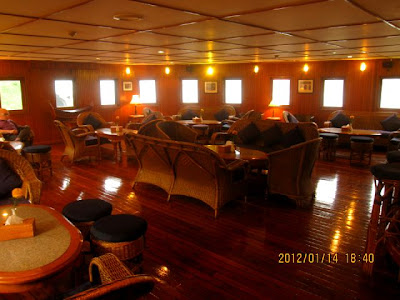










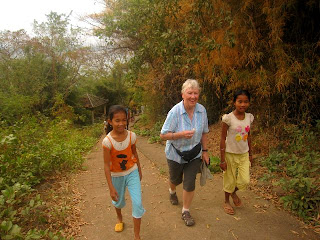












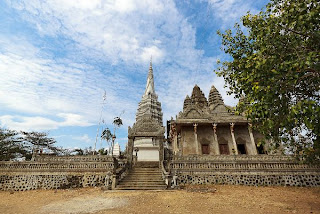

























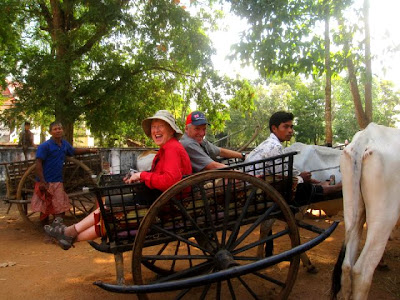





































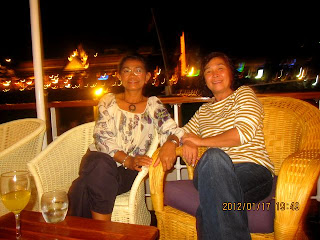
































































































































No comments:
Post a Comment